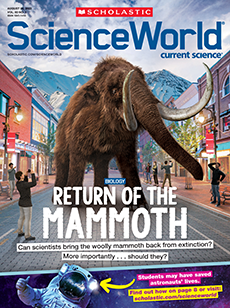One night in 1610, Italian astronomer Galileo Galilei was peering through a telescope at Saturn when he noticed something odd. The planet appeared to have an unusual shape, almost like a round head with two ears sticking out. A few decades later, astronomer Christiaan Huygens realized that these “ears” were actually the outer edges of Saturn’s most famous feature: its rings.
In modern telescope images, Saturn’s rings may look like a series of smooth, flat discs circling the planet. But observations in the late 1800s showed that the rings aren’t solid. They’re made up of billions of chunks of ice, along with some rocks and dust. All these pieces—some smaller than a grain of sand and others bigger than a school bus—orbit around Saturn.
For hundreds of years, people have wondered how the sixth planet from the sun got its rings (see Our Solar System). Scientists still aren’t 100 percent sure about their origins. The leading hypothesis is that tens of millions of years ago, rocky asteroids, icy comets, or possibly even a moon drifted too close to Saturn. The pull of the planet’s gravity may have torn the approaching object or objects to pieces. The resulting jumble eventually flattened into Saturn’s iconic rings.
Although the rings have been around for a long time, they won’t last forever. In fact, they’re disintegrating at this very moment. Tiny particles from the rings continually fall out of orbit, showering Saturn with debris called ring rain. Studying this phenomenon could help solve the mystery of how Saturn’s rings formed—as well as how long it will be before they’re gone for good.
One night in 1610, Italian astronomer Galileo Galilei peered through a telescope at Saturn. He noticed something odd. The planet appeared to have an unusual shape. It looked almost like a round head with two ears sticking out. A few decades later, astronomer Christiaan Huygens identified these “ears.” They were actually the outer edges of Saturn’s most famous feature: its rings.
In modern telescope images, Saturn’s rings may look like smooth, flat discs around the planet. But observations in the late 1800s showed that the rings aren’t solid. They’re made up of billions of chunks of ice, plus some rocks and dust. Some of these pieces are smaller than a grain of sand. Others are bigger than a school bus. All of them orbit around Saturn.
How did the sixth planet from the sun get its rings? People have wondered for hundreds of years (see Our Solar System). Scientists still aren’t 100 percent sure about the rings’ beginnings. The leading idea involves rocky asteroids, icy comets, or a moon. Tens of millions of years ago, one or more of these objects drifted too close to Saturn. The pull of the planet’s gravity may have torn the object or objects to pieces. Over time, the jumble flattened into Saturn’s famous rings.
The rings have been around for a long time, but they won’t last forever. In fact, they’re falling apart at this very moment. Tiny particles from the rings constantly fall out of orbit. They shower Saturn with material called ring rain. Studying ring rain could help solve the mystery of how Saturn’s rings formed. It could also reveal how much time is left before they’re gone for good.

